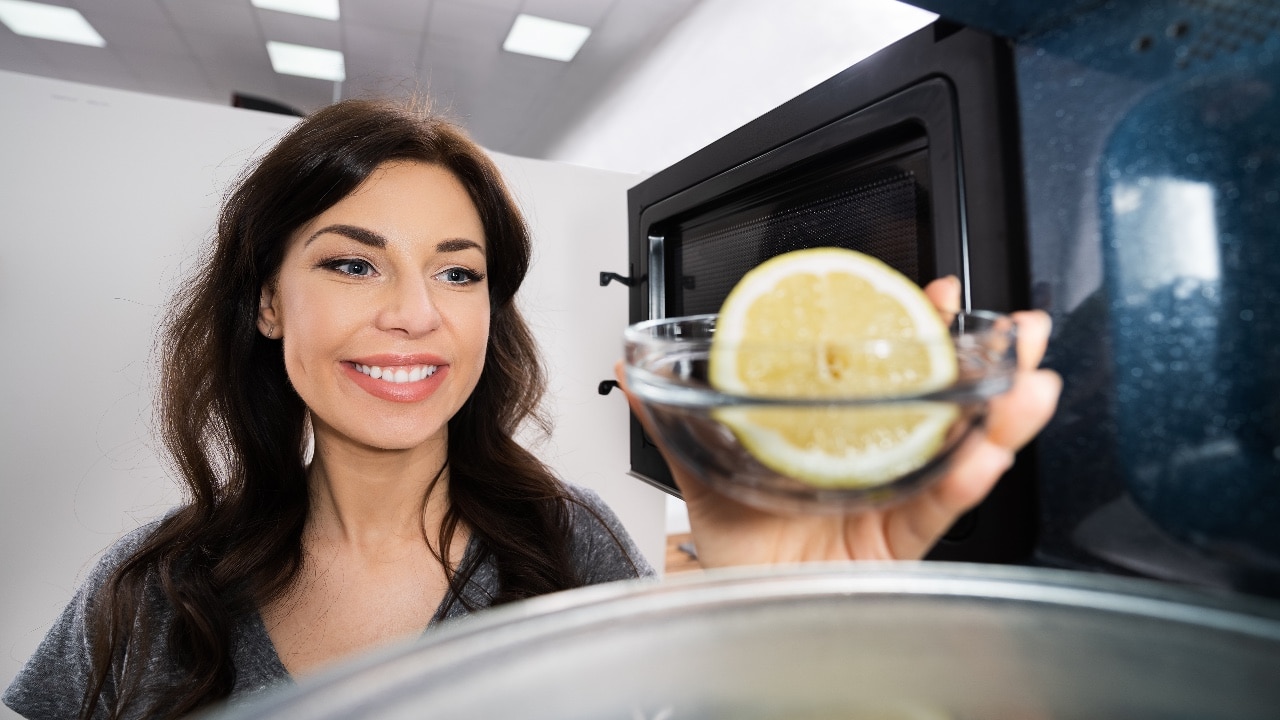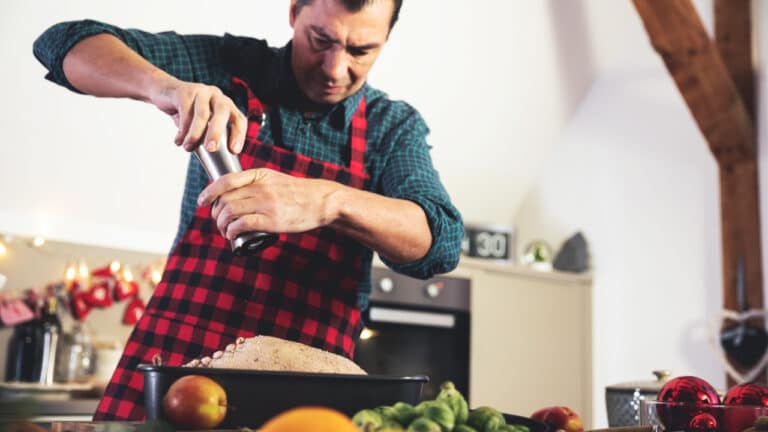13 Surprising Things You Can Do With Your Microwave Oven

Surprise — microwave ovens are not just for warming up leftovers and cooking frozen dinners. Did you know that you can use that microwave energy to sanitize items, make hard bread soft again, remove stamps, and even help clean the oven itself?
Engineer Percy Spencer filed a patent for the microwave oven in 1945, but it took decades for the kitchen appliances to become commonplace in American homes. Food gets cooked when its water molecules absorb the oven’s microwave energy and heat the food, leaving microwave-safe plates and bowls unaffected.
As we approach the 80th anniversary of the microwave oven, what would Spencer think about the following creative uses for his revolutionary invention?
Disinfect Sponges

Sponges absorb spills and clean up messes, but they also collect a ridiculous amount of harmful bacteria between uses because the sponges don’t dry out quickly.
To sanitize a sponge in a microwave, make sure the sponge is wet and nuke it for about one minute on high. This will kill all of the bacteria in the sponge. If your sponge of choice has metal bits for scrubbing, skip the microwave (metal is a no-no) and sanitize that sponge in your dishwasher instead.
Sterilize Toothbrushes

Like sponges, toothbrushes can also harbor harmful bacteria if they are not disinfected regularly.
To sterilize a nonelectric toothbrush in a microwave, place the toothbrush in a shallow, microwave-safe dish and fill it with water high enough to cover the bristles. Microwave on high for two minutes and resume brushing your choppers with the knowledge that you aren’t putting bacteria right back in your mouth.
Liquify Dried Mascara

You don’t have to throw out that tube of liquid mascara you accidentally let dry out by not closing it tightly.
First, make sure the mascara cap is screwed on tightly, and submerge the tube in a mug of water. Heat on the microwave for about a minute and, after you allow the water to cool enough to remove the tube, the mascara inside should be soft enough to use again.
Dry Herbs

If you grow fresh mint, basil, oregano, or other fresh herbs and want to dry them out quickly, your microwave is your friend.
The Food Network recommends separating the stems from the leaves and placing the latter on a paper towel on a microwave-safe plate. Place another paper towel on top of the leaves, pat down, and heat in the microwave for 30-second intervals. Check to make sure that you aren’t scorching the leaves and repeat for about two minutes total cooking time to get those dried herbs ready for crumbling.
Revive Stale Bread

Have you ever taken home soft bread from, say, an Italian restaurant and put it in your fridge only to later discover that the bread is as hard as a brick? All hope is not lost.
Wrap the rocky piece of bread in a damp paper towel and place it on a microwave-safe plate. Heat for 10 to 20 seconds on high, which allows the starch molecules in the bread to react with the water on the paper towel. The bread will be almost as soft as it was when you were served it at the restaurant.
Make Garlic Easier to Peel

The biggest turnoff to using fresh garlic is the peeling process. Yes, there are knife tricks and other gadgets out there to simplify the process, but you already have the appliance you need right in your kitchen: a microwave oven.
Toss an entire garlic head in your microwave and zap for about 20 seconds on high. You’ll find that peeling off those husks just got exponentially easier.
Make Citrus Fruits Juicier

If you make your own juice from fresh lemons, limes, or oranges, you’ll get more juice out of each piece of fruit by microwaving them first.
Place two uncut citrus fruits in your microwave and heat on high for 20 seconds. According to a test performed by the Kitchn, juicing a lemon out of the fridge produced less than 2/3 of a cup of juice, whereas the microwaved lemons yielded 3/4 of a cup of juice. Use your microwave to get juiced!
Make Healthier Potato Chips

If you make your own potato chips in the oven or a frier, you’ll need oil to cook the chips. The microwave eliminates the need for any cooking oil.
The key to successfully making potato chips in a microwave is to cut the slices as thin as possible using a mandolin. Place the potato slices on a paper towel on a plate and sprinkle the slices with salt or the spices of your choice. Microwave on high for three minutes. Then flip the slices, reduce the microwave power to half, and microwave for another three minutes. Remove any chips that look fully cooked and continue cooking the rest at half power for one-minute intervals until all the chips are golden brown, crispy, and ready to gobble.
Quickly Soak Beans

The reason people soak dry beans is to reduce cooking time, but that doesn’t mean that you have to plan ahead and let the beans soak overnight.
In a microwave-safe bowl, add a cup of beans and three cups of water. Microwave on high for 15 minutes and then let the beans rest in the water for an hour. Instead of waiting overnight for the beans to soak, your microwave just shaved off hours of prep time.
Fix Congealed Salad Dressing

If you make your own salad dressing using olive oil and vinegar, sometimes the olive oil will congeal in the bottle. This is normal, especially if your refrigerator is set a tad colder than most.
To make your salad dressing look more like something you’d pour over lettuce instead of eating with a spoon, simply heat the bottle in the microwave for about 10 seconds. Shake the bottle and, if the oil still looks congealed, repeat the process in the microwave. After one or two intervals, the salad dressing should look like it’s supposed to.
Make a Warm Compress

If you have aches and pains and want a warm compress sooner rather than later, Dr. Microwave is ready to see you now.
Wet a hand towel and squeeze out the excess water until it is just damp. Place in a ziplock bag, making sure to leave the bag slightly open, and microwave for about two minutes. While it’s heating up, dampen another towel with warm water and wring out the excess. Take the hot bag out of the microwave and wrap the towel that you just prepared around the hot bag. Voila! You just made a warm compress in less than five minutes.
Remove Postage Stamps

Whether you placed a postage stamp on an envelope that you want to remove or you received a letter with a collectible stamp that you would like to save, your microwave can help.
Simply place the envelope in the microwave and heat for 10 seconds. The microwave energy will soften the adhesive on the back of the stamp for easy removal. If for some reason 10 seconds doesn’t do the trick, repeat at 10-second intervals until that stubborn stamp peels off.
Clean a Microwave Oven

The best way to clean caked-on residue from the inside of a microwave is to use the oven to help clean itself.
In a microwave-safe bowl, place a half cup of water and the juice of one lemon. Heat on high for two minutes and then let it sit in the microwave for another minute or so before removing it. The steam will not only loosen the splatter for easier removal, but the lemon juice will leave a fresh and clean scent.





